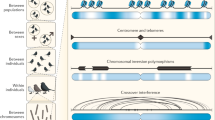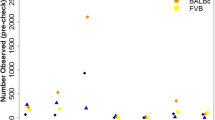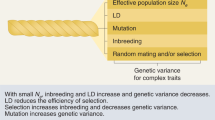Abstract
We describe a technique, genetically directed representational difference analysis (GDRDA), for specifically generating genetic markers linked to a trait of interest. GDRDA is applicable, in principle, to virtually any organism, because it requires neither prior knowledge of the chromosomal location of the gene controlling the trait nor the availability of a pre–existing genetic map. Based on a subtraction technique described recently called representational difference analysis, GDRDA uses the principles of transmission genetics to create appropriate Tester and Driver samples for subtraction. We demonstrate the usefulness of GDRDA by, for example, successfully targeting three polymorphisms to an interval of less than 1 cM of the mouse nude locus of chromosome 11.
This is a preview of subscription content, access via your institution
Access options
Subscribe to this journal
Receive 12 print issues and online access
$209.00 per year
only $17.42 per issue
Buy this article
- Purchase on Springer Link
- Instant access to full article PDF
Prices may be subject to local taxes which are calculated during checkout
Similar content being viewed by others
References
Collins, F. Positional cloning: let's not call it reverse anymore. Nature Genet. 1, 3–6 (1992).
Lisitsyn, N., Lisitsyn, N. & Wigler, M. Cloning the difference between two complex genomes. Science 259, 946–951 (1993).
Snell, G.D. Histocompatibility genes of the mouse. II. Production and analysis of isogenic resistant lines. J. natn. Cancer Inst. 21, 843–877 (1958).
Hillyard, A.L., Doolittle, D.P., Davisson, M.T., Maltais, L. & Roderick, T.H. Locus map of the mouse with comparative map points of human on mouse. (GBASE Electronic Database, Jackson Laboratory, Bar Harbor, Maine, March, 1993).
Williams, J.G.K., Reiter, R.S., Young, R.M. & Scolnick, P.A. Genetic Mapping of mutations using phenotypic pools and mapped RAPD markers. Nucl. Adds Res. 21, 2697–2702 (1993).
Lyon, M.F. & Searle, A.G. Genetic Variants and Strains of the Laboratory Mouse 2nd edn (Oxford Univeristy Press, Oxford, 1989).
Brown, T. in Current Protocols in Molecular Biology (eds Ausubel, F. et al.) 2.9.1–2.9.15 (Green, New York, 1993).
Dietrich, W. et al. A Genetic Map of the Mouse Suitable for Typing lntraspecific Crosses. Genetics 131, 423–447 (1992).
Whitehead Institute/MIT Center for Genome Research, Mouse Genome Public Electronic Database, “genome_database@genome.wi.mit.edu” (July, (1993).
Author information
Authors and Affiliations
Rights and permissions
About this article
Cite this article
Lisitsyn, N., Segre, J., Kusumi, K. et al. Direct isolation of polymorphic markers linked to a trait by genetically directed representational difference analysis. Nat Genet 6, 57–63 (1994). https://doi.org/10.1038/ng0194-57
Received:
Accepted:
Issue Date:
DOI: https://doi.org/10.1038/ng0194-57
This article is cited by
-
Genetically directed differential subtraction chain products related to in vitro response of immature embryos of rye (Secale cereale L.): isolation, characterization, and expression analysis
Plant Cell, Tissue and Organ Culture (PCTOC) (2010)
-
Novel strategies to clone identical and distinct DNA sequences for several complex genomes
Molecular Biology (2000)
-
Isolation of DNA markers for the ratSai 1 gene for suppression of anchorage independence by using representational difference analysis
Somatic Cell and Molecular Genetics (1997)
-
Selective amplification of protein-coding regions of large sets of genes using statistically designed primer sets
Nature Biotechnology (1996)
-
Pituitary lineage determination by the Prophet of Pit-1 homeodomain factor defective in Ames dwarfism
Nature (1996)



